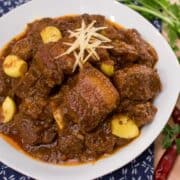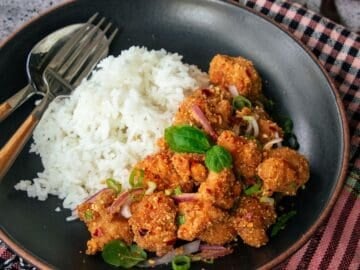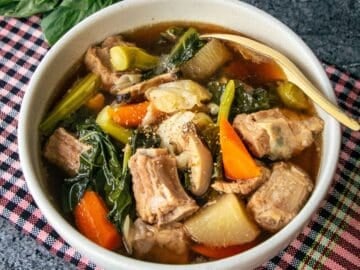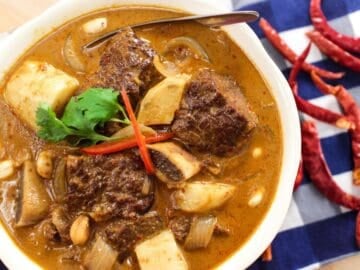Gaeng Hung Lay แกงฮังเล is one of the most iconic dishes of Northern Thailand, and arguably one of the tastiest! Pork belly and pork ribs are slowly stewed in a WHOLE bunch of herbs and spices. The result is tender fatty pieces of pork that has been entirely permeated by the rich and aromatic sauce. It is a dish to impress, and though it takes time, most of the process is hands-off!

This dish came to Northern Thailand via Myanmar, which in turn has a lot of Indian influences on their cuisine. This is why there are a lot of spices in this recipe, and why you can use Indian garam masala which you can buy from Indian grocery stores instead of making your own hung lay curry powder.
Ingredients and Notes
Here are all the ingredients you'll need to make this recipe and important notes about them. For amounts, check out the full recipe card below.
The Curry
- Pork belly, cut into big chunks
- Pork spare rib tips, chopped
- Tamarind paste, if buying tamarind paste, look for tamarind in a jar that is from Thailand (sometimes labeled as tamarind concentrate). It should have a pourable consistency. If it is very thick and not pourable, add one tablespoon at a time and taste before adding more. You can also make it from pulp using this recipe.
- Dark brown sugar or palm sugar
- Black soy sauce or dark soy sauce, optional, you can add more or less to get the colour you like.
- Fish sauce
- Garlic, peeled, but keep cloves whole
- Pearl onions or Thai small shallots
- Julienned ginger
Hung Lay Curry Paste
Tip: No time to make the curry paste? "Cheat" by combining 3-4 tablespoon store bought red curry paste with 2 tablespoon hung lay curry powder or garam masala.
- Dried mild red chilies. I use dried guajillo peppers for colour because they're mild, and then add a few dried arbol or Thai chilies to adjust the heat. In Thailand, the mild dried chilies you're looking for is spur chilies or "prik chee fa."
- Garlic
- Chopped shallots
- Lemongrass, bottom half only, chopped
- Galangal
- Turmeric (or 1 ½ teaspoon powdered turmeric)
- Hung lay curry powder (recipe below, or use garam masala)
- Fermented shrimp paste (gapi)
Hung Lay Curry Powder
Whole spices are always preferred as the flavours are more aromatic when freshly ground, but if you don't have it, ground version can be substituted.
- Cinnamon stick or ground cinnamon
- Black peppercorns
- Turmeric powder, you can also pound fresh turmeric root into the curry paste
- Green cardamom
- White cardamom, these can be found a Chinese grocery stores.
- Cumin seeds
- Coriander seeds, this is the one spice I ask you use whole because in my experience ground coriander has so much less flavour than whole.
- Star anise
- Cloves
- Nutmeg
- Fennel seeds
How to Make Gaeng Hung Lay
Here are all the steps to make this recipe. If this is your first time, I highly recommend watching the video tutorial to ensure success.
Make Hunglay Curry Powder:
- For whole spices, toast them in a dry saute pan until aromatic and darkened slightly. You can combine spices of similar size and toast them at the same time.
- Then combine all spices in a coffee grinder or blender and grind into a powder.
- Once made, store in an airtight container in a cool, dark place. You will have more than you need for this recipe, so feel free to use it as rubs, marinades, or on vegetables!
Make the curry paste:
- Grind dried chilies into a powder in a coffee/spice grinder, removing the seeds if you want to reduce the heat.
- If using an immersion blender: combine lemongrass, galangal, turmeric, shallots, garlic and shrimp paste, and blend into a paste. Add the ground dry spices and blend just to mix.
- If using a mortar and pestle: start by pounding lemongrass and galangal into a fine paste. Then add turmeric and pound until fine, then add shallots and garlic until fine. Then add the shrimp paste and ground dry spices and pound to mix.
- If using a regular blender: combine lemongrass, galangal, turmeric, shallots, garlic and shrimp paste, and blend into a paste. If it's too thick you can add a little water to get it going, but only add as much as needed. Pour
- Add the dried chilies and the hung lay curry powder and blend just until well combined.
Save this recipe!
Make the curry:
- Preheat a wok or large pot over medium heat, do not add any oil as there will be a lot of pork fat rendered. Add the pork belly pieces in one layer, and without crowding the pan, and let them sear until well browned on 4 sides. They will stick at first but once they are browned they will release from the pan.
- Add the pork ribs and give it a quick toss. Then add the curry paste and toss to coat all pieces of pork well. Once the paste is well distributed and it has had a couple of minutes to fry in the pork fat, add water just until it barely covers the pork.
- Add fish sauce, black soy sauce, tamarind and sugar, and cook for 1 hour 45 mins to 2 hours, loosely covered, until the pork is fork tender.
- Towards the last 20 minutes, check the amount of liquid, and if it's very soupy, uncover the pot completely to allow liquid to evaporate. You want the sauce to be thick and rich in the end.
- Once pork is tender add julienned ginger, whole garlic and pearl onions and simmer for another 15-20 minutes until the garlic is tender. You can add a little more water at any point if it gets to dry.
- Taste and adjust seasoning.
- Garnish with extra fresh julienned ginger if desired and serve with rice, enjoy! This curry can also be made in advance and kept in the fridge, and it'll keep well in the fridge for at least a week.
Watch The Full Video Tutorial!
All my recipes come with step-by-step video tutorials with extra tips not mentioned in the blog post, so make sure you watch the video below to ensure success - and if you enjoy the show, please consider subscribing to my YouTube channel. Thank you!
Recipe Card
Print
Gaeng Hung Lay - Northern Pork Belly Curry แกงฮังเล
- Prep Time: 20 mins
- Cook Time: 2 hr 30 mins
- Total Time: 2 hrs 50 mins
- Yield: 4 servings
Description
Gaeng Hung Lay is an iconic curry of northern Thailand. Pork belly and spare ribs are braised in an aromatic and rich curry sauce full of spices, accented with fresh ginger.s
Ingredients
Save this recipe!
Serves 4
Hung Lay Curry Paste (see note)
- 8-10 grams dried mild red chilies, plus some spicier ones to taste (see note)
- 5 cloves garlic
- ⅓ cup chopped shallots
- 1 stalk lemongrass, bottom half only, chopped
- 5 slices galangal
- 2-inch pc turmeric (or 1 ½ tsp powdered turmeric)
- 2 tablespoons hung lay curry powder (recipe below, or use garam masala)
- 1 teaspoon fermented shrimp paste (gapi)
The Curry
- 1 lb (450 g) pork belly, cut into big chunks
- 1 lb (450 g) pork spare rib tips, chopped
- ¼ cup tamarind paste, make sure it is Thai tamarind with a pourable consistency, or make it from pulp using this recipe (see note 3)
- 2 Tbsp dark brown sugar or palm sugar
- 1-2 teaspoon black soy sauce or dark soy sauce (optional, you can add more or less to get the colour you like)
- 1 ½ - 2 tablespoon fish sauce
- 1 head garlic (peeled, but keep cloves whole)
- ½ cup pearl onions or Thai small shallots
- ¼-⅓ cup julienned ginger
Hung Lay Curry Powder
- 1 8-inch cinnamon stick
- 2 tsp black peppercorns
- 2 tsp turmeric powder
- 1 tsp ground cardamom
- 2 Tbsp cumin seeds
- 2 Tbsp coriander seeds
- 1 star anise
- 1 tsp ground clove or 3 pc whole clove
- ½ tsp nutmeg
- 2 tsp fennel
- 5 pc white cardamom
Instructions
Make Hunglay Curry Powder:
- For whole spices, toast them in a dry saute pan until aromatic and darkened slightly. You can combine spices of similar size and toast them at the same time.
- Then combine all spices in a coffee grinder or blender and grind into a powder.
- Once made, store in an airtight container in a cool, dark place. You will have more than you need for this recipe, so feel free to use it as rubs, marinades, or on vegetables!
Make the curry paste:
- Grind dried chilies into a powder in a coffee/spice grinder, removing the seeds if you want to reduce the heat.
- If using an immersion blender: combine lemongrass, galangal, turmeric, shallots, garlic and shrimp paste, and blend into a paste. Add the ground dry spices and blend just to mix.
- If using a mortar and pestle: start by pounding lemongrass and galangal into a fine paste. Then add turmeric and pound until fine, then add shallots and garlic until fine. Then add the shrimp paste and ground dry spices and pound to mix.
- If using a regular blender: combine lemongrass, galangal, turmeric, shallots, garlic and shrimp paste, and blend into a paste. If it's too thick you can add a little water to get it going, but only add as much as needed. Pour
- Add the dried chilies and the hung lay curry powder and blend just until well combined.
Make the curry:
- Preheat a wok or large pot over medium heat, do not add any oil as there will be a lot of pork fat rendered. Add the pork belly pieces in one layer, and without crowding the pan, and let them sear until well browned on 4 sides. They will stick at first but once they are browned they will release from the pan.
- Add the pork ribs and give it a quick toss. Then add the curry paste and toss to coat all pieces of pork well. Once the paste is well distributed and it has had a couple of minutes to fry in the pork fat, add water just until it barely covers the pork.
- Add fish sauce, black soy sauce, tamarind and sugar, and cook for 1 hour 45 mins to 2 hours, loosely covered, until the pork is fork tender.
- Towards the last 20 minutes, check the amount of liquid, and if it's very soupy, uncover the pot completely to allow liquid to evaporate. You want the sauce to be thick and rich in the end.
- Once pork is tender add julienned ginger, whole garlic and pearl onions and simmer for another 15-20 minutes until the garlic is tender. You can add a little more water at any point if it gets to dry.
- Taste and adjust seasoning.
- Garnish with extra fresh julienned ginger if desired and serve with rice, enjoy! This curry can also be made in advance and kept in the fridge, and it'll keep well in the fridge for at least a week.
Notes
- No time to make the curry paste? "Chet" by combining 3-4 tablespoon store bought red curry paste with 2 tablespoon hung lay curry powder or garam masala.
- Dried chilies: I use dried guajillo peppers for colour because they're mild, and then add a few dried arbol or Thai chilies to adjust the heat. In Thailand, the mild dried chilies you're looking for is spur chilies or "prik chee fa."
- If buying tamarind paste, look for tamarind in a jar that is from Thailand (sometimes labeled as tamarind concentrate). It should have a pourable consistency. If it is very thick and not pourable, add one tablespoon at a time and taste before adding more.





Catherine McHugh says
Made the Gaeng Hung Lay at the weekend, and whilst it did seem quite labour intensive, I think it was because I’d never done it before, but when, not if, I make this again, I think it’ll be easier.
The pork (I used belly pork and pork shoulder) absolutely melted and the flavour .. wow, it was the best and most flavourful curry I’ve ever made. Thank you for taking the time to share this incredible recipe.
Alison Joy Quartaro says
So delicious! A lot of work so I suggest you make extra and freeze it. But so good!
Alexis Schaitkin says
Would you suggest leaving the skin on the pork belly or removing it? If leaving it on, is the goal to get crispy pork belly skin, or not since it will end up slow-cooked in the curry? Thank you!
Pailin Chongchitnant says
Then skin will not get crispy, so you can leave it on or take it off depending on whether you like the gelatinous texture of braised pork belly skin. I like it 🙂
Mark Warner says
If you're a fan of this site and you haven't made this dish, you are missing out! This curry is amazing and worth the time that it takes. It's like no other Thai curry that you've had. I guess the closest curry would be a Massaman but I actually prefer this one. Try it!!!!
Tim says
Hello,
Do you think I can use Instant Pot to sucessfully make Hung Lay curry?
Also, do you cook your jasmine rice in instant pot?
Pailin Chongchitnant says
if you add all of the liquid to the IP it won't reduce at all and you'll have a watery curry. If you reduce the liquid to what the end product would have...it might work..assuming it won't scorch at the bottom. I never cook rice in the IP, I tried it and it's not as good as a rice cooker.
Donna says
is it 8-10 grams dried chili for the paste or 8 to 10 chilies? The meat is in pounds, confused about the "g" in the chili measurement
Pailin Chongchitnant says
Hi Donna, sorry for the late response but it is in grams, it's just hard to be that precise with pounds and ounces! But I will add g to the meat as well 🙂
Donna says
Thank you! I made it using grams (as I suspected) and it is so good!!! Thank you again.
Dan says
Fantastic recipe as always! One question is how would you double (or triple) this? Whenever I've tried making a big pot of hung lay, the extra water takes much longer to reduce, leaving the pork almost too tender by the end (shreds easily, looks almost like carnitas once served, especially if you use shoulder instead of spare rib tips).
Any recommendations? Also, would you do a straight doubling, or only increase some of the ingredients? Particularly wondering about the curry paste.
Thanks so much!
Pailin Chongchitnant says
Hi Dan, glad you love the recipe! So I would double all ingredients proportionally, and there are few solutions to long cooking time. 1) Do not cover the pan at all (my recipe says loosely cover) 2) Use a wider pan for faster evaporation 3) cut the pork bigger so they take longer 4) remove the pork once they are perfect and continue reducing the sauce. #4 would be what I'd do as it is the most controlled method.
Dan says
Thank you so much, Pailin! Will try that next time.
Robert says
Hi Pailin,no peanuts?
Pailin Chongchitnant says
Not usually, but you can add them if you like them.
JR says
Amazing! The instructions are easy to follow and the results delicious. We were sad that the only restaurant in town with this dish closed down, but this recipe fills that gap.
SNL says
Substitute for pearl onions and shrimp paste please. I have the rest of the ingredients 🙁
Alex says
I lived in Chiang Mai for a while and when I returned to the US, this was probably the dish I missed the most but I couldn't find it at any Thai restaurants. I learned to make it using this recipe and it tastes exactly how I remember it. Thank you so much for this recipe!
Richard says
Fabulous recipe. I have made this several times. I use pickled garlic instead of fresh garlic to give it an extra depth. This curry is rich as opposed to the brightness of other Thai curries.
Thank you for giving all of us this recipe.
Diane T says
Hi Pailin; is it possible to hydrate the dried chillis first and then blend it with the rest of the ingredients for this recipe? This is how we do it for most South East Asian curries.
Pailin Chongchitnant says
You can but there is no need to rehydrate them if you're going to use a coffee grinder to grind the chilies. We only hydrate them to soften if we're going to pound them by hand.
Helen says
Please clarify regarding the cinnamon in your hung lay curry powder mix.
Is it an 8 inch long cinnamon stick?
Thank you.
Pailin Chongchitnant says
Correct.
rob says
being a lover of both indian and thai food i had to have a go at this, i wasn't disappointed, a very complex taste, served with sticky rice, sai oua, grilled pork marinated in turmeric, garlic and galangal, pork crackling and a dynamite chilli ketchup dipping sauce.
Ian C says
Delicious recipe. I may have overdone it with the tamarind paste slightly. How tangy is it traditionally made? Will recreate in future to perfect it better. Other specific recs for use for the curry powder?
Pailin Chongchitnant says
It's not very tangy at all. It shouldn't taste sour, the tamarind is there to "brighten" the flavour, making the richness less heavy. The curry powder can be used anywhere you'd use any curry powder! Try my "gaeng ho" recipe, a glass noodle stir fry which also uses this curry powder.
Ian C says
Maybe its a difference w the tamarind paste then. I remember a similar thing when i attempted your pad thai recipe. I made it work it work tho. Suppose my next question would be how spicy should it be? I used both guajillo and arbol peppers. Seeds removed. But used a bit more sugar to compensate for the tamarind. The curry paste was def spicy, but at the end of it, by 2yr old was drinking the curry like soup... he has been a lil adjusted to spicy thinga tho
Stephen Chan says
Quite a unique curry to try, the ginger and whole garlic cloves make it different from other Thai curries.